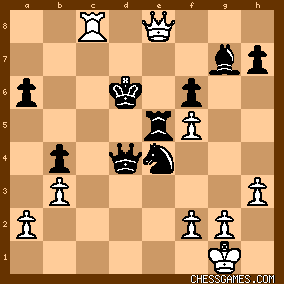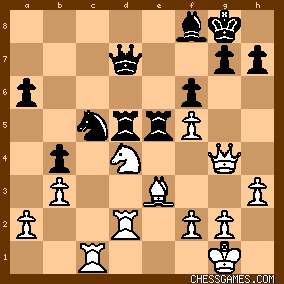| Jul-22-04 | | Gypsy: "Once I was lucky and created my own pearl ..." (David Bronstein, 200 Open Games) After Black 28-th move, Bronstein describes 7 different tactical notions that ran through his head as if at different valences of playing strength: (1) Qxg7 to mate (unrated player); (2) Q-h5-e8 (1300); (3) rooks to back rank (1500); (4) rooks to seventh rank (1700); this needs a clever bluff (1900); (5) sac the pride N on d4? (expert); (6) pull that Black knight away, it defends too much (master); (7) bait with rook, and aim for c8 (IM). But, I guess, it takes the whole Bronstein to put it all together. Bronstein: "From the educational point of view, moves 29-40 can be divided into three independent parts: (i) the trap 29-34; (ii) the combination 35-36; and (iii) the forced follow-through 36-40 and 40...Nd6 41.Rxd6+ Ke4 42Rxd4#." |
|
Jul-23-04
 | | Honza Cervenka: 39.Qd8# would have been more accurate finish.
What about 33...Nc5? It looks like a very unpleasant counterblow. |
|
| Jul-23-04 | | Gypsy: I am always amased by all you see <Honza>. Bronstein does not mention your <39.Qd8#> in his book and I surmise that time-pressure had him blindly follow his precomputed line to the longer check-mate. In fact, that precomputed line probably set in a long-term "blind spot". As for the intermezzo <33...Nc5>, I think that 34.Rxd7 Rxg4 35.Bxc5 gives White good winning chances. For instance, 35...Rge4 36.Rd8 Re8 37.Rxe8 Rxe8 38.Bxf8 Kxf8 39.Kf1 leaves White in a good spot. Of course, Bronstein would have been anoyed to no end to miss on his combination. All of this is in the preparatory, trap stage of the combination (31.h3 looks like a prep for Nc5). Objectively, 33...Nc5 is better for Black than the game. But I am sure Gligoric had high hopes for the position after 33...Qd5. (I certainly would.) |
|
Jul-23-04
 | | Honza Cervenka: Well, 33...Nc5 was not bad idea (definitely better than Gligoric's 33...Qd5) but it doesn't work well enough. 33...Nc3 is another candidate move for improvement of black's play, although after 34.Rxd7 Rxg4 35.hxg4 Ne2+ (After 35...Rxe3 36.fxe3 Ne2+ 37.Kf2 Nxc1 38.Rd2 it is not easy to liberate the Knight, for example 38...g6 39.Kf3 a5 40.Ke4 a4 41.bxa4 b3 42.axb3 Nxb3 43.Ra2 Nc5+ 44.Kd5 doesn't look much promising for black.) 36.Kf1 Nxc1 37.Bxc1 Ra5 38.Rd2 h5 39.f3 hxg4 40.hxg4 g6 41.Rf2 Kf7 white has still some advantage. |
|
| Jul-23-04 | | Gypsy: Nice variations <Honza>; good improvement for Black. (There is a small typo, I think, ... 39.f3 hxg4 <40.fxg4> ...) |
|
Jul-26-04
 | | Honza Cervenka: <Gypsy> Of course, it was a typo. 40.fxg4 is correct. |
|
| Jul-26-04 | | Gypsy: With typos like that, I never know whether to point them out and look like a pedant, or whether to knowingly let such a minor flaw persist. Damn if you do, damn if you don't... |
|
| Jul-26-04 | | suenteus po 147: <Gypsy: Damn if you do, damn if you don't...> LOL It's damned if you do, damned if you don't. Very clever of you :) |
|
| Jul-27-04 | | Gypsy: Well, <damned> felt so ... biblical ... so I thought it deserved a bit of "modernization". In general, < suenteus po 147>, English and I keep each other rather amused. Fortunately, English is a durable language. :-) |
|
| Jul-27-04 | | Benzol: <Gypsy> You and <Honza> type (and probably speak) English very well. I doubt very much that I could type or speak your language at all! |
|
| Jul-27-04 | | Gypsy: Thanks <Benzol> for your support. Honza, of course, is a classy act throughout. |
|
| Oct-19-05 | | Averageguy: In The Sorcerers Apprentice, Bronstein points out that 33...Nc3 wins for black. |
|
| May-16-10 | | tstavernman: In his book "The Chess of Gligoric" David N.L. Levy quotes Gligoric (who cooperated with the book's publication):
"I came to play Bronstein. He is a very good friend of mine. A round earlier he made a short draw with Smyslov with White. Then he played me with White, and he tried to beat me. He made me work. I sacrificed a pawn because I was in trouble and somehow I had the better game. Then he offered me a draw. At any other time I would have accepted because I didn't want to risk anything,
but at that moment I was a little bit angry because he had made me suffer for such a long time and I refused. He was in time trouble. I had no reason to refuse because I had no winning position. At that point I underestimated him--he made a beautiful combination and mated me. That was my first loss and I was very upset. Then I lost three more games, one from a winning position against Stein." |
|
| Feb-03-11 | | wordfunph: Bronstein-Gligoric
after 38...Kd6

click for larger viewBronstein missed a mate-in-one with 39.Qd8# |
|
| Jan-12-12 | | Llawdogg: Wow! Nice combination. And Wow! David Bronstein missed a mate in one. |
|
| Jun-09-12 | | screwdriver: How do you know he missed the mate in 1? #1, He may not have even looked for it since he had a forcing winning variation with Re6#. #2, He may just want to see his opponent suffer since his opponent didn't resign at a reasonabe time. #3, If Bronstein's game fell apart after his 39th move, then one can say he missed the mate in 1. |
|
| Apr-23-13 | | engmaged: It is more surprising that Kotov in his book "Chess Tactics" (diagram 30) missed also 29.Qd8#?!
If Bronstein missed it OTB how could Kotov missed it in a book!
I think he was not thinking like a grandmaster by then!:p |
|
Feb-23-14
 | | Sally Simpson: "How do you know he missed the mate in 1?"
Because Bronstein in 'The Sorcerer's Apprentice' states he missed the mate in one due to severe time trouble. He also states he is thankful for time trouble because thanks to it Gligorich failed to find 33...Nc3!! 
click for larger viewThe double exclams come from Bronstein.
-------
"#2, He may just want to see his opponent suffer since his opponent didn't resign at a reasonable time. " How can anyone think such a thing of Bronstein, and anyway, when you are severe time trouble it you who is doing the suffering. ---
Bronstein never mentions his psychological draw offer, it obviously had an effect on Gligorich because he never forgot it. Now in what position did Bronstein offer his draw?
I've had this discussion before on another site and the general feeling is it here. 
click for larger viewBronstein played 31.h3 (and offered a draw?)
Gypsy is correct in saying "31.h3 looks like a prep for Nc5." Was a draw offered also as added prep for Nc5. |
|
| Apr-24-14 | | DrGridlock: Bronstein comments on this game twice, in “200 Open Games” (in 1973) and in “The Sorcerer’s Apprenticer” (in 1995). His comments indicate that his views on this game progressed, and also give us an interesting insight into Bronstein’s approach to chess. In 1973, Bronstein entitles his comments “The Art of Improvisation” and writes, People come to the sanctuary of Chess Art with a sole aim: to delight in the beauty of combination. … In order, however, to create an individual combination, one has to work extrememly hard and it is essential to study the work of one’s colleagues and masterpieces of players of years gone by. … Once I was lucky; I created my own pearl, and now I want to boast about it to you. … From the educational point of view moves 29-40 can be divided into three independent parts The Trap (moves 29 to 34)
The combination (moves 35 and 36)
The forced continuation (moves 36 to 42 (forced mate had the game continued). By 1995, Bronstein’s views on this game seem to have changed. He writes, “What is a combination in the game of chess? There are many opinions and nobody has a uniform answer. Sometimes I think that a combination consists of a – not too long – series of moves with material sacrifices which contain a high element of risk.” Contrast this with Botvinnik’s definition of a combination (from “100 Selected Games” in 1951): “Then what is a combination? A combination is a forced variation with a sacrifice.” Botvinnik had extended Romanovsky’s earlier definition of a combination: “A combination is a variation in the course of which both sides make forced moves and which ends with an objective advantage for the active side,” To include the inclusion of a “sacrifice.”
Bronstein extendes Botvinnik’s definition to include “a high element of risk.” Bronstein elaborates on his extension,
“But if there is a risk why is such a string of moves considered to be forced? Because it only “appears” to be forced, but in reality a combination contains many possibilities which are almost impossible to see while playing a tense game and which are, during subsequent analysis in a more relaxed atmosphere, still difficult to find.” Bronstein elaborates on how this applies to this game, “We should be modest and not, as some super computers of super humans, think that we are able to see everything. When I played 30 Rc1 I expected to win with a brilliant combination: 30 … Ne4, 31 Rdc2 Rxd4, 32 Rc7 Qd5, etc. However, while Gligoric was thinking, I suddenly realised my mistake. After 32 … Nc5, 33 Qxd4 Qxc7 34 b4 Nb3 35 axb3 Qxc1+, 36 Bxc1 Re1#, using the boomerang the brilliant combination comes from the black side. That is why I played 31 h3 to make a shelter for my King on h2 and proposed a draw. But Gligoric also did not see everything!” Between 1973 and 1995, Bronstein seemed to realize that “the trap” need not ensare his opponent. |
|
| Apr-24-14 | | DrGridlock: Komodo helps us to understand this:

click for larger viewAnalysis by Komodo32 3 32bit:
1. ± (0.90): 29.Qf3 h5 30.h3 b4 31.g4 hxg4 32.hxg4 Qb7 33.Rc1 Qd7 34.Ne2 Nd3 35.Rcd1 Re8 36.Nf4 Nxf4 37.Bxf4 Rd8 38.Rxd5 Qxd5 39.Kg2 Bc5 40.Re1 Qxf3+ 41.Kxf3 Rd3+ 42.Be3 Bxe3 43.Rxe3 Rd2 44.Re2 Rd3+ At move 29, White has a “positional” way to a significant advantage in the game after playing 29 Qf3. Instead, Bronstein plays for “the trap” with 29 Rd2. Komodo also suggests that 30 … Ne4 and 31 … Re4 would have been an positional improvements for black over the game continuations. (With an approximately even game for Black.) Some have argued that 33 … Nc3 “saves” the game for black. While it avoids the instant loss that 33 … Qd5 leads to, after 33 … there is still a significant positional advantage for White. 
click for larger viewAnalysis by Komodo32 3 32bit:
1. ± (0.75): 33...Nc3 34.Rxd7 Rxg4 35.hxg4 Ne2+ 36.Kh2 Nxc1 37.Bxc1 Ra5 38.Rd2 g6 39.fxg6 hxg6 40.Kg3 Rc5 41.Bb2 Kf7 42.Kf3 Rc6 43.Bd4 Bh6 44.Re2 Rc1 45.Kg3 Bf8 46.Rd2 Rc8 47.Be3 Rc3 48.Rd7+ Ke6 49.Ra7 It is insightful that at move 29 Bronstein had a choice between continuing “positionally” or “combinationally” and accepted the “high element of risk” that Gligoric might find a refution to the combination over the board. Gligoric did not, and Bronstein, “was lucky, [and] created [his] own pearl.” |
|
| Nov-15-23 | | tibone: I calculated Rxg7+ Bxg7 Rc8+ Kf7 Qh5+ Ke7 Qe8+ Kd6 Rc6 and thought this would mate, but Black can still play Kd5 |
|
|
|
|





































